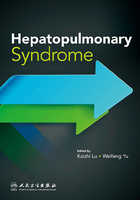
上QQ阅读APP看书,第一时间看更新
Chapter 4 Clinical Features and Diagnosis of Hepatopulmonary Syndrome
Clinical Features
Hepatopulmonary Syndrome (HPS) presents the abnormal dilation of pulmonary micro vessels as well as the abnormalities in both gas exchange and arterial oxygenation on the basis of chronic liver disease and/or portal hypertension. The prevalence of HPS in cirrhotic patients is assessed to range from 5% to 32% 1. This prevalence variation of HPS is dependent on different cut-offs used for defining abnormalities in arterial gas exchange. Patients, with or without cirrhosis, at all ages may suffer from HPS. Most cases of HPS are concurrent with the presence of either cirrhotic or non-cirrhotic portal hypertension including splenomegaly, esophageal varices,or ascites; but presence of portal hypertension is not necessary for the development of syndrome;moreover, it seems that the presence or severity of HPS is not correlated with and the severity of liver disease at all, according to the Child-Turcotte-Pugh classifcation or the Model for End-Stage Liver Disease (MELD) 2. It has been reported that patients with HPS are subjected to 2-fold risk of mortality compared to cirrhotic patients without HPS independently of the severity of cirrhosis 3, 4.
Although the majority of patients with HPS often present asymptomatic, gradually progressive dyspnea (annual decline in PaO 2 of 5 mmHg/year) isregarded as the most representative symptom 2. Patients with hepatic failure are more likely to suffer from dyspnea because of the disease itself and its complications including ascites with increased abdominal girth, pleural effusions, medication effects, anemia, or deconditioning. It has been reported that the liver transplantation (LT) candidates with HPS have more occurrence chance of dyspnea than those without HPS or other lung diseases (48% vs. 28%) 3. Platypnea (a type of shortness of breath improved by lying supine)and orthodeoxia (hypoxemia aggravated by standing up)aretwo characteristic signs observed in 25% of patients with HPS owing to the fact that dilated vessels in the lung basesallow much moreblood fow passing through when patient position is sitting upright 5. In almost 70% of HPS patients, oxygen saturation is reduced during sleep; and more serious HPS is, more oxygen saturation is decreased. Obviously serious hypoxemia during sleep may happen in HPS patients, while only mild-to-moderate hypoxemia occurs during waketime 6. Brain cells are very sensitive to hypoxia and respiratory alkalosis can lead to headache dizziness and numbness in hands and feet. Therefore, in some patients with HPS, hyperventilation and serious hypoxia could lead to the damage of nervous system such as encephaledema and intracranial hypertension. However, these symptoms are not specific enough to discriminate between HPS and other diseases such as recurrent pulmonary thromboemboli, cardiac failure and atrial septal defects.
Several features, including spider nevi, digital clubbing, and cyanosis, can be observed in patients with severe HPS. The elevation of estradiol due to hepatopathy can remarkably infuence veins and arteries, which may cause some cutaneous stigmas such as spider nevi in HPS. It is considered that patients who suffer from cutaneous spider nevi may often be accompanied with systemic and pulmonary vascular dialation, and severe gas exchange abnormalities. In a study of the correlation between spider nevi and HPS in 40 patients with liver cirrhosis, Silverio A.O., et al. found that the presence of HPS is much higher in patients with spider nevi than those without this sign (38.1% vs. 5.3%, P<0.01). Thus, they assumed that symptom of spider nevi is the skin marker of the HPS occurrence 7. Digital clubbing is attributed to the vasodilation of distal blood vessels and secretion of growth factors (such as platelet-derived growth factor and hepatocyte growth factor) from the lungs. Although these clinical features are also not specifc for diagnosis of HPS, their concurrence with hypoxia in patients with liver disease indicates a high level of HPS clinical suspicion. Therefore, it is necessary for doctors to make clinical judgment in order to illustrate the severity of hypoxemia in the HPS and in coexisting pulmonary conditions such as chronic obstructive pulmonary disease or pulmonary fbrosis, furthermore, 30% of patients with HPS may have these conditions 8.
Zamirian M., et al. have revealed that left atrial enlargement is associated with HPS,which refects that HPS developes in the context of increased cardiac output, and they also have demonstrated that left atrial volume LAV≥50 ml is a simple and feasible parameter to detect HPS 9. Subsequently, Pouriki S., et al. further confrmed that systolic velocity in mitral valve can also be used as a good indirect indicator of HPS 10. Patients with HPS could present limbs fushing and powerful pulse due to hyperdynamic circulation. They also present hypotension because of both increased cardiac output and decreased peripheral resistance; however, chronic heart failure rarely occurs. It has been confrmed that most patients have cardiac enlargement and 2-3 degree systolic murmur could be heard in the region of tricuspid valve. A summary of clinical features in HPS is shown in Table 4.
Table 4. A summary of clinical features in HPS
